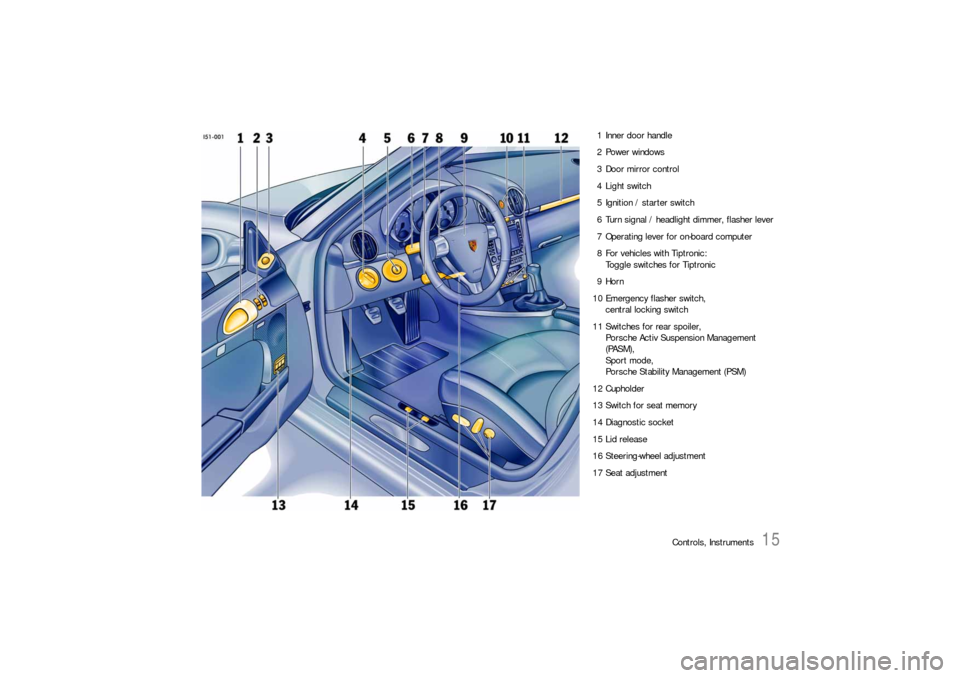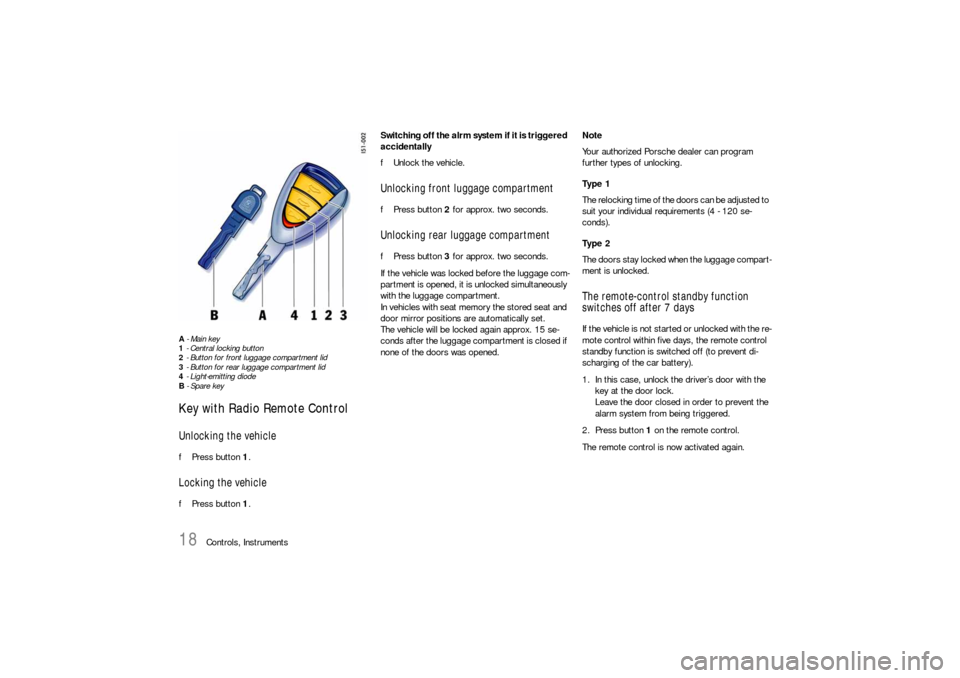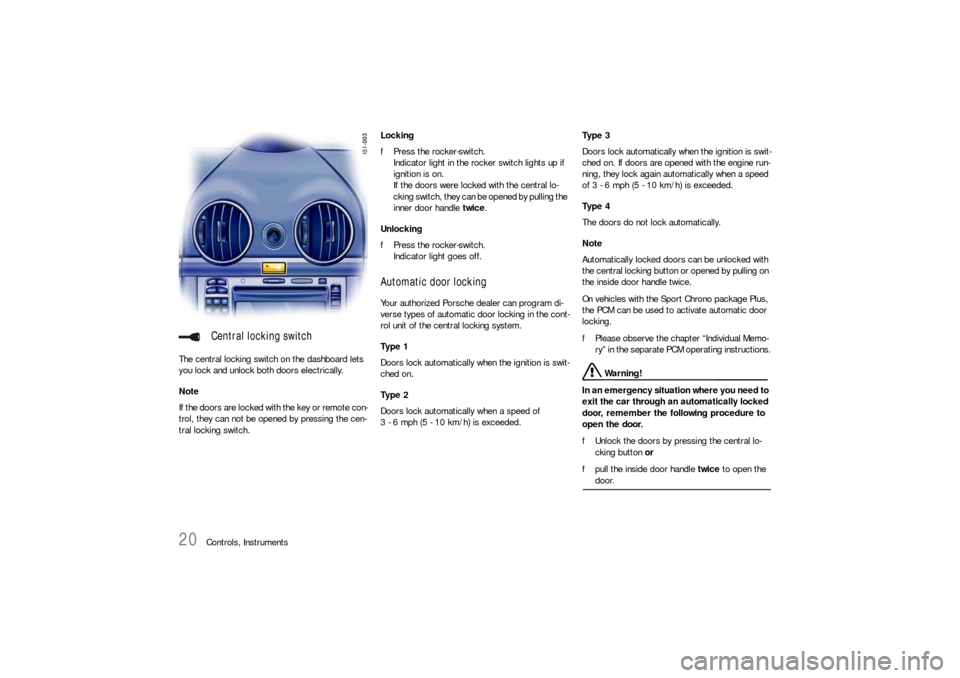light PORSCHE BOXSTER 2005 2.G Owners Manual
[x] Cancel search | Manufacturer: PORSCHE, Model Year: 2005, Model line: BOXSTER, Model: PORSCHE BOXSTER 2005 2.GPages: 276, PDF Size: 4.05 MB
Page 2 of 276

2Dear Owner, we would like to thank you for your purchase of a
Porsche Sports car.
Judging by the car you have chosen, you are a mo-
torist of a special breed, and you are probably no
novice when it comes to automobiles.
Remember however, as with any vehicle, you
should take time to familiarize yourself with your
Porsche and its performance characteristics. Al-
ways drive within your own unique capabilities as
a driver and your level of experience with your
Porsche. Ensure that anyone else driving your
Porsche does the same. To prevent or minimize in-
jury, always use your safety belts. Never consume
alcohol or drugs before or during the operation of
your vehicle.
This Owner’s Manual contains a host of useful in-
formation. Please take the time to read this manu-
al before you drive your new Porsche. Become fa-
miliar with the operation of your Porsche car for
maximum safety and operating pleasure. The bet-
ter you know your Porsche, the more pleasure you
will experience driving your new car.
Always keep your Owner’s Manual in the car, and
give it to the new owner if you ever sell your
Porsche. A separate Maintenance Booklet explains how
you can keep your Porsche in top driving condition
by having it serviced regularly.
A separate Warranty and Customer Informa-
tion Booklet contains detailed information about
the warranties covering your Porsche.
For U.S. only:
If you believe that your vehicle has a fault which
could cause a crash, injury or death, you should
immediately inform the National Highway Traffic
Safety Administration (NHTSA) in addition to
notifying Porsche Cars North America, Inc.
(Porsche Cars N.A.).
If NHTSA receives similar complaints, it may open
an investigation, and if it finds that a safety pro-
blem exists in a group of vehicles, it may order a
recall and remedy campaign. However, NHTSA
cannot become involved in individual problems
between you and your dealer, or Porsche Cars
N.A..
To contact NHTSA, you may either call the Auto
Safety Hotline toll-free at 1(800)424-9393 (or
366-
0123 in Washington, D.C. area) or write to: NH-
TSA, U.S. Department of Transportation, Washing-
ton, D.C. 20590. You can also obtain other infor-
mation about motor vehicle safety from the Hot-
line. Your car has thousands of parts and components
which have been designed and manufactured in
accordance with Porsche’s high standards of engi-
neering quality and safety.
Any alteration of the vehicle may negate or
interfere with those safety features built into
the vehicle. Modifications may be carried out
on your vehicle only if approved by Porsche.
Your Porsche is intended to be used in a safe man-
ner obeying the local laws and in the light of dri-
ving conditions faced by you, and in accordance
with the instructions provided in this Owner’s Ma-
nual.
Do not misuse your Porsche by ignoring
those laws and driving conditions, or by
ignoring the instructions in this manual.
Any alteration or misuse of the vehicle can
lead to accidents and severe or fatal person
al injuries.
The fitting of racing tires (e.g. slicks) for sporting
events is not approved by Porsche. Very high cor-
nering speeds can be achieved with racing tires.
However, the resulting transverse acceleration va-
lues would jeopardize the adequate supply of oil to
the engine.
Porsche therefore will not accept any warranty or
accept any liability for damage occurring as a re-
sult of non-compliance with this provision.
Page 4 of 276

4Fuel Quality Your engine is designed to provide optimum performance and fuel economy using
unleaded premium fuel with an octane rating of 98 RON (93 CLC or AKI).
Porsche therefore recommends the use of these fuels in your vehicle.
Porsche also recognizes that these fuels may not always be available. Be assured that your vehicle will operate
properly on unleaded premium fuels with octane numbers of at least 95 RON (90 CLC or AKI),
since the engine’s “Electronic Oktane™ knock control” will adapt the ignition timing, if necessary. Fuels containing alcohol and ether Some areas of the U.S. require oxygenated fuels during certain portions of the year.
Oxygenated fuels are fuels which contain alcohols (such as methanol or ethanol) or ether (such as MTBE).
Under normal conditions, the amount of these compounds in the fuel will not affect driveability.
You may use oxygenated fuels in your Porsche, provided the octane requirements for your vehicle are met.
We recommend, however, to change to a different fuel or station if any of the following problems occur with your vehicle:
– Deterioration of driveability and performance.
– Substantially reduced fuel economy.
– Vapor lock and non-start problems, especially at high altitude or at high temperature.
– Engine malfunction or stalling. Fuels containing MMT Some North American fuels contain an octane enhancing additive called methylcyclopentadienyl manganese tricarbonyl (MMT).
If such fuels are used, your emission control system performance may be negatively affected.
The check engine warning lights on your instrument panel may turn on.
If this occurs, Porsche recommends you stop using fuels containing MMT.
Page 7 of 276

7
Environmentally friendly vehicles Modern environmental technology ensures compli-
ance with all emission laws applicable worldwide.
It has the following advantages:
– Rapid operational readiness of the catalytic
converters ensures low emissions, even in
short-trip operation.
– Reliable operation and good emission control
over a long useful life.
– Please observe the chapter “FUEL ECONOMY”
on Page 177.
Recycling – for a Porsche, this is virtually
an academic question More than two-thirds of all Porsches ever built are
still running.
Just in case recycling is ever necessary, we
take the following precautionary measures:
– Identification of all materials.
– Use of recyclable materials.
– Reusable components designed for simple
removal.
– These reasons result in a further increase in
the recycling rate which is currently 80 per
cent.
Emission control is built in Innovative engine technology combines high engi-
ne performance and environmental compatibility.
The engine diagnosis system electronically moni-
tors the components and systems that affect ex-
haust gases.
This continuous monitoring and fault storage en-
ables swift, reliable diagnosis and fault detection.
Any fault messages are indicated to the driver by
the “Check Engine” warning light and the on-board
computer.
fPlease observe the chapter “WARNINGS ON
THE INSTRUMENT PANEL AND THE ON-
BOARD COMPUTER” on Page 102.
Page 11 of 276

Controls, Instruments
11 Controls, Instruments
Before driving off .......................................... 12
Break in hints for the first
2,000 miles/3,000 kilometers ...................... 14
Keys ........................................................... 17
Security Wheel Bolts .................................... 17
Central Locking in Cars
without Alarm System................................... 19
Doors ......................................................... 25
Alarm System,
Passenger Compartment Monitoring ............. 26
Power Windows ........................................... 28
Inside mirror ................................................ 30
Automatic Anti-Glare
Interior Mirror and Door Mirrors .................... 30
Door Mirrors................................................ 31
Seat Adjustment .......................................... 34
Seat Memory ............................................... 36
Heated Seats .............................................. 38
Steering Wheel Adjustment ........................... 39
Multi-functional steering wheel....................... 40
Sun Visors................................................... 41
Safety Belts................................................. 42
Child Restraint Systems................................ 45
Key-operated airbag deactivation device ........ 46
LATCH System
Child seat bracket on the passenger’s seat .... 47
Key-operated airbag deactivation device ........ 48
Airbag Systems ........................................... 49
Clutch Pedal ................................................ 51
Parking Brake .............................................. 51
Brakes ........................................................ 52ABS Brake System
(Antilock Brake System) ................................ 55
Sport Mode ................................................. 57
Porsche Stability Management (PSM)............. 58
Porsche Active Suspension Management
(PASM) ........................................................ 61
Retractable Spoiler ...................................... 62
Parking Aids ................................................ 64
Ignition/Starter Switch with anti-theft Steering
Lock ........................................................... 67
Starting Procedures ..................................... 69
Stopping engine........................................... 70
Instrument Panel USA Models ....................... 73
Automatic Speed Control Indicator light ......... 76
Instrument Illumination.................................. 76
Trip Odometer ............................................. 77
Speedometer .............................................. 78
Changing over between
Miles / Kilometers........................................ 78
Tachometer ................................................. 79
Turn Signal Indicator Light ............................ 79
High Beam .................................................. 79
Cooling System ........................................... 80
Tiptronic ...................................................... 81
Fuel ............................................................ 82
Clock .......................................................... 83
Outside temperature .................................... 83
Check Engine Warning Light.......................... 84
Central warning light .................................... 85
Brake warning light USA ............................... 85
Brake warning light Canada .......................... 85On-Board Computer (BC)............................... 86
Light Switch .............................................. 108
Welcome Home Lighting............................. 108
Automatic Headlight Beam Adjustment......... 109
Turn Signal/ Headlight Dimmer/Parking light /
Flasher Lever............................................. 109
Windshield Wiper / Washer Lever ................ 110
Automatic Speed Control ............................ 112
Air conditioning .......................................... 114
Automatic air conditioning system ............... 117
Central and side vents................................ 120
Fresh-air intake .......................................... 120
Emergency Flasher Switch .......................... 121
Ashtray ..................................................... 122
Cigarette Lighter ........................................ 123
Sockets .................................................... 124
Interior lights ............................................. 125
Storage in the passenger compartment ....... 126
Cupholder
(holder for drinks cans and cups) ................ 128
Luggage Storage on
Engine Compartment Lid ............................. 130
Fire extinguisher ........................................ 131
Trunk Entrapment ...................................... 132
Luggage compartment lids ......................... 134
Luggage Compartment.............................. 136
Rear luggage compartment ........................ 137
Porsche Communication Management
(PCM) ........................................................ 138
Car Audio Operation/Tips ........................... 139
HomeLink .................................................. 142
Page 12 of 276

12
Controls, Instruments
Dear Porsche Owner A lot has gone into the manufacture of your
Porsche, including advanced engineering, rigid
quality control and demanding inspections.
These engineering and safety features will be
enhanced by you... the safe driver... – who knows his car and all controls,
– who maintains the vehicle properly,
– who uses driving skills wisely, and always
drives within her/his own capabilities and the
level of familiarity with the vehicle.
You will find helpful hints in this manual on how to
perform most of the checks listed on the following
pages.
If in doubt, have these checks performed by your
authorized Porsche dealer.
Before driving off... Check the following items first fTurn the engine off before you attempt any
checks or repairs on the vehicle.
fBe sure the tires are inflated correctly.
Check tires for damage and tire wear.
fSee that wheel bolts are properly tightened
and not loose or missing.
fCheck engine oil level, add if necessary.
Make it a habit to have engine oil checked with
every fuel filling.
fCheck all fluid levels such as windshield was-
her and brake fluid levels.
fBe sure the vehicle battery is well charged and
cranks the engine properly.
fCheck all doors and lids for proper operation
and latch them properly.
fCheck and if necessary replace worn or cra-
cked wiper blades.
fSee that all windows are clear and unobstruc-
ted.
fCheck air intake slots and area between front
lid and windshield are free of snow and ice, so
the heater and the windshield wipers work pro-
perly. fIf a child will be riding in the vehicle, check
child seat/child seat restraint system to ensure
that restraints are properly adjusted.
fCheck all exterior and interior lights for opera-
tion and that the lenses are clean.
fCheck the headlights for proper aim, and if ne-
cessary, have them adjusted.
fCheck under the vehicle for leaks.
fBe sure all luggage is stowed securely.
Emergency equipment It is good practice to carry emergency equipment
in your vehicle.
Some of the items you should have are:
window scraper, snow brush, container or bag of
sand or salt, emergency light, small shovel, first-
aid kit, etc.
Page 13 of 276

Controls, Instruments
13
In the driver’s seat... fCheck operation of the horn.
fPosition seat for easy reach of foot pedals and
controls.
To reduce the possibility of injury from the air-
bag deployment, you should always sit back as
far from the steering wheel as is practical,
while still maintaining full vehicle control.
fAdjust the inside and outside rear view mirrors.
fBuckle your safety belts.
fCheck operation of the foot and parking brake.
fCheck all warning and indicator lights with
ignition on and engine not running.
fStart engine and check all warning displays for
warning symbols.
fNever leave an idling car unattended.
fLock doors from inside, especially with child-
ren in the car to prevent inadvertent opening of
doors from inside or outside.
Drive with doors locked.
On the road... fNever drive after you have consumed alcohol
or drugs.
fAlways have your safety belt fastened.
fAlways drive defensively.
Expect the unexpected.
fUse signals to indicate turns and lane changes.
fTurn on headlights at dusk or when the driving
conditions warrant it.
fAlways keep a safe distance from the vehicle in
front of you, depending on traffic, road and
weather conditions.
fReduce speed at night and during inclement
weather.
Driving in wet weather requires caution and re-
duced speeds, particularly on roads with stan-
ding water, as the handling characteristics of
the vehicle may be impaired due to hydropla-
ning of the tires.
fAlways observe speed limits and obey road
signs and traffic laws.
fWhen tired, get well off the road, stop and take
a rest. Turn the engine off. Do not sit in the ve-
hicle with engine idling.
fPlease observe the chapter “ENGINE EX-
HAUST” on Page 8.fWhen parked, always set the parking brake.
Move the Tiptronic selector lever to ”P“ or the
gearshift lever to reverse or first gear.
On hills also turn the front wheels toward the
curb.
fWhen emergency repairs become necessary,
move the vehicle well off the road. Turn on the
emergency flasher and use other warning de-
vices to alert other motorists. Do not park or
operate the vehicle in areas where the hot ex-
haust system may come in contact with dry
grass, brush, fuel spill or other flammable ma-
terial.
fMake it a habit to have the engine oil checked
with every fuel filling.
Danger!
Danger of fire in engine compartment due to
burning cigars or cigarettes.
fDo not throw any lit cigars or cigarettes out of
the vehicle.
They can be blown into the air inlets by the air
flow and cause a fire in the engine compart-
ment.
fPlease observe the chapter “ASHTRAY” on Page 122.
Page 14 of 276

14
Controls, Instruments
Break in hints for the first
2,000 miles/3,000 kilometers The following tips will be helpful in obtaining opti-
mum performance from your new Porsche.
Despite the most modern, high-precision manufac-
turing methods, it cannot be completely avoided
that the moving parts have to wear in with each
other. This wearing-in occurs mainly in the first
2,000 miles/3,000 km. Therefore: fPreferably take longer trips.
fAvoid frequent cold starts with short-distance
driving whenever possible.
fAvoid full throttle starts and abrupt stops.
fDo not exceed maximum engine speed of
4,200 rpm (revolutions per minute).
fDo not run a cold engine at high rpm either in
Neutral or in gear.
fDo not let the engine labor, especially when dri-
ving uphill. Shift to the next lower gear in time
(use the most favorable rpm range).
fNever lug the engine in high gear at low
speeds. This rule applies at all times, not just
during the break-in period. fDo not participate in motor racing events,
sports driving schools, etc. during the first
2,000 miles/3,000 kilometers.
There may be a slight stiffness in the steering,
gear-shifting or other controls during the break-in
period which will gradually disappear.
Break in brake pads and break discsNew brake pads and discs have to be “broken in”,
and therefore only attain optimal friction when the
car has covered several hundred miles or km.
The slightly reduced braking ability must be com-
pensated for by pressing the brake pedal harder.
This also applies whenever the brake pads and
brake discs are replaced. New tires New tires do not have maximum traction. They
tend to be slippery.
fBreak in new tires by driving at moderate
speeds during the first 60 to 120 miles/100 to
200 km. Longer braking distances must be an-
ticipated.
Engine oil consumption During the break-in period oil consumption may be
higher than normal.
As always, the rate of oil consumption depends on
the quality and viscosity of oil, the speed at which
the engine is operated, the climate and road con-
ditions, as well as the amount of dilution and oxi-
dation of the lubricant.
fMake a habit of checking engine oil with every
fuel filling, add if necessary.
Page 15 of 276

Controls, Instruments
15
1 Inner door handle
2 Power windows
3 Door mirror control
4 Light switch
5 Ignition / starter switch
6 Turn signal / headlight dimmer, flasher lever
7 Operating lever for on-board computer
8 For vehicles with Tiptronic:
Toggle switches for Tiptronic
9Horn
10 Emergency flasher switch,
central locking switch
11 Switches for rear spoiler,
Porsche Activ Suspension Management
(PASM),
Sport mode,
Porsche Stability Management (PSM)
12 Cupholder
13 Switch for seat memory
14 Diagnostic socket
15 Lid release
16 Steering-wheel adjustment
17 Seat adjustment
Page 18 of 276

18
Controls, Instruments
A - Main key
1 - Central locking button
2 - Button for front luggage compartment lid
3 - Button for rear luggage compartment lid
4 - Light-emitting diode
B - Spare key Key with Radio Remote ControlUnlocking the vehiclefPress button 1.Locking the vehiclefPress button 1.Switching off the alrm system if it is triggered
accidentally
fUnlock the vehicle.
Unlocking front luggage compartment fPress button 2 for approx. two seconds. Unlocking rear luggage compartment fPress button 3 for approx. two seconds.
If the vehicle was locked before the luggage com-
partment is opened, it is unlocked simultaneously
with the luggage compartment.
In vehicles with seat memory the stored seat and
door mirror positions are automatically set.
The vehicle will be locked again approx. 15 se-
conds after the luggage compartment is closed if
none of the doors was opened. Note
Your authorized Porsche dealer can program
further types of unlocking.
Ty p e 1
The relocking time of the doors can be adjusted to
suit your individual requirements (4 - 120 se-
conds).
Ty p e 2
The doors stay locked when the luggage compart-
ment is unlocked.
The remote-control standby function
switches off after 7 days If the vehicle is not started or unlocked with the re-
mote control within five days, the remote control
standby function is switched off (to prevent di-
scharging of the car battery).
1. In this case, unlock the driver’s door with the
key at the door lock.
Leave the door closed in order to prevent the
alarm system from being triggered.
2. Press button 1 on the remote control.
The remote control is now activated again.
Page 20 of 276

20
Controls, Instruments The central locking switch on the dashboard lets
you lock and unlock both doors electrically.
Note
If the doors are locked with the key or remote con-
trol, they can not be opened by pressing the cen-
tral locking switch. Locking
fPress the rocker-switch.
Indicator light in the rocker switch lights up if
ignition is on.
If the doors were locked with the central lo-
cking switch, they can be opened by pulling the
inner door handle twice.
Unlocking
fPress the rocker-switch.
Indicator light goes off.
Automatic door locking Your authorized Porsche dealer can program di-
verse types of automatic door locking in the cont-
rol unit of the central locking system.
Ty p e 1
Doors lock automatically when the ignition is swit-
ched on.
Ty p e 2
Doors lock automatically when a speed of
3 - 6 mph (5 - 10 km/h) is exceeded. Ty p e 3
Doors lock automatically when the ignition is swit-
ched on. If doors are opened with the engine run-
ning, they lock again automatically when a speed
of 3 - 6 mph (5 - 10 km/h) is exceeded.
Ty p e 4
The doors do not lock automatically.
Note
Automatically locked doors can be unlocked with
the central locking button or opened by pulling on
the inside door handle twice.
On vehicles with the Sport Chrono package Plus,
the PCM can be used to activate automatic door
locking.
fPlease observe the chapter “Individual Memo-
ry” in the separate PCM operating instructions.
Warning!
In an emergency situation where you need to
exit the car through an automatically locked
door, remember the following procedure to
open the door.
fUnlock the doors by pressing the central lo-
cking button or
fpull the inside door handle twice to open the door.
Central locking switch